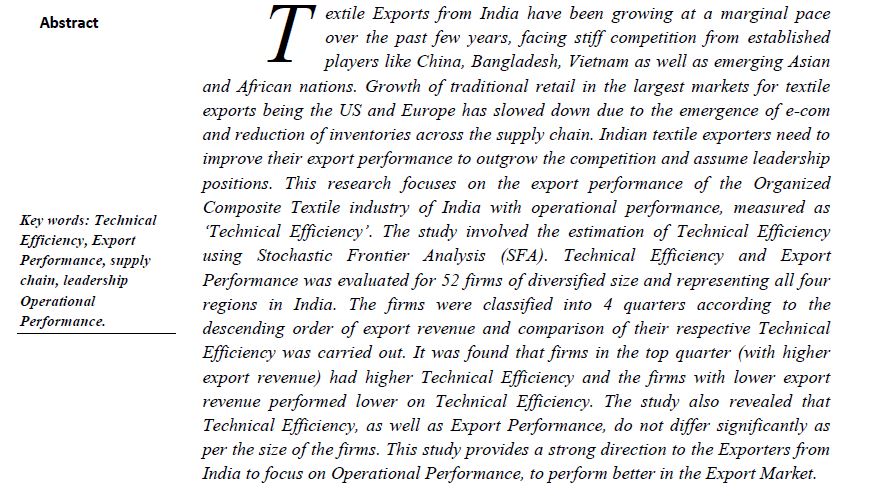Estimation of Technical Efficiency and Evaluation of Its Relationship with Export Performance of Organized Composite Textile Industry in India
Abstract
Textile Exports from India have been growing at a marginal pace over the past few years, facing stiff competition from established players like China, Bangladesh, Vietnam as well as emerging Asian and African nations. Growth of traditional retail in the largest markets for textile exports being the US and Europe has slowed down due to the emergence of e-com and reduction of inventories across the supply chain. Indian textile exporters need to improve their export performance to outgrow the competition and assume leadership positions. This research focuses on the export performance of the Organized Composite Textile industry of India with operational performance, measured as ‘Technical Efficiency’. The study involved the estimation of Technical Efficiency using Stochastic Frontier Analysis (SFA). Technical Efficiency and Export Performance was evaluated for 52 firms of diversified size and representing all four regions in India. The firms were classified into 4 quarters according to the descending order of export revenue and comparison of their respective Technical Efficiency was carried out. It was found that firms in the top quarter (with higher export revenue) had higher Technical Efficiency and the firms with lower export revenue performed lower on Technical Efficiency. The study also revealed that Technical Efficiency, as well as Export Performance, do not differ significantly as per the size of the firms. This study provides a strong direction to the Exporters from India to focus on Operational Performance, to perform better in the Export Market.
Downloads
References
Allen, Ronald Maurice (2008), Performance Measurement of Textile and Apparel Supply Chains in Developing Countries, A Dissertation Submitted to the Graduate Faculty of North Carolina State University in the partial fulfillment of the requirement for the Degree of Doctor of Philosophy, North Carolina
Ambastha, Ajitabh and Dr. Momaya, K (2004), Competitiveness of Firms: Review of Theory, Frameworks, and Models, Singapore Management Review, volume 26, #1, pp 45-62
Anand, Meenakshi (2014), A study of Financial Analysis in Textile Sector, Journal of Business Management & Social Sciences Research, Vol 3 No 6, June 2014
Bedi, Dr. Jatinder S et al (2009), Assessing the prospects for India’s Textile and Clothing sector, National Council of Applied Economic Research, (July) Report submitted to Ministry of Textile, Government of India
Bedi, Jatinder S, Cororaton, Caesar B (2008), Cotton-Textile-Apparel Sectors of India: Situations and Challenges Faced, International Food Policy Research Institute (IFPRI) Discussion paper 00801 (September)
Berdine, Matt, Parrish Erin, Cassil Nancy L, Oxenham, William (2008), Measuring the Competitive Advantage of the US Textile and Apparel Industry, Alfred P Sloan Foundation Industry Studies, Annual Conference, Boston MA (May 1-2)
Bhandari, Anup Kumar, and Ray, Subhash C (2007), Technical Efficiency in the Indian Textile Industry: A Non-parametric Analysis of Firm-Level Data, University of Connecticut, Economics Working Paper (November)
Bhandari, A. K. and P. Maiti (2007), “Efficiency of Indian Manufacturing Firms: Textile Industry as a Case Study”, International Journal of Business and Economics, 6 (1), 71-88.
Bloom N, Eifert B, Mahajan A, Mckenzie D, Roberts J (2013), Does Management Matters? Evidence from India, The Quarterly Journal of Economics, Vol 128 # 1 (Feb)
Bosloper, Michael J et al (2006), Economic Conditions and How It Effects Trade between the U.S. And India, International Business and Economics Journal, Vol 5 #3 (March)
Bruce, Margaret (2004), Lean or agile: A solution for supply chain management in the textiles and clothing industry, International Journal of Operations & Production Management, Vol. 24 #2 pp 151-170 Capitaline database, website accessed on 27 Jan 2018 Dhanabhakyam,
Dr. M and Latha, M, Indian Textile Industry: Brand Strategy and Export competitiveness, Fiber to Fashion, www.fibre2fashion.com, accessed on 27 Jan 2014
Dhange, Vaibhav (2013), Techno-Economic Efficiency in the apparel industry, International Journal of Fiber & Textile Research, 3(3): 60-62
Dhiman, Rahul and Sharma, Manoj (2015), Determinants Affecting Indian Textile Exports: A Review, Biz, and Bytes (Vol. 6. Issue: 2), pp195-201
Dhiman, Rahul and Sharma, Manoj (2017), Productivity Trends and Determinants of Indian Textile Industry: A is aggregated Analysis, International Journal of Applied Business and Economic Research, Volume 15, Number 22 (Part 2) pp 113-124
Douglas, Kibirige (2008), Analysis of the impact of the agricultural productivity enhancement program on the technical and allocative efficiency of Maize farmers in Masandi district, Makerere University, Kampala, Uganda (Sept)
Erkoc, Taptuk Emre (2012), Estimation Methodology of Economic Efficiency: Stochastic Frontier Analysis vs Data Envelopment Analysis, International Journal of Academic Research in Economics and Management Sciences, Vol. 1, No. 1 (Jan)
Gautam, Madhur, Nagarajan, Hari K, Pradhan, Kailash C (2012), Technical, economic and allocative efficiency and its determinants of Indian agricultural farmers using ARIS/REDS panel data, NCAER Working Papers on Decentralization and Rural Governance in India, # 16 (Nov)
Graner, Mats and Isakson, Anders (2007), Firm efficiency and the destination of exports: Evidence from Kenyan plant-level data, Research and Statistics Branch, United Nations Industrial Development Organization, Staff working paper (March)
Gupta, Varsha (2017), A Study of Performance Evaluation of Select Textile Industries An Empirical Analysis, IOSR Journal of Business and Management, Vol 19 Issue 1 Ver III Jan 2017 pp 54-58
Jakhar, S K and Barua, Dr. M K (2012), Performance Measures for the textileapparel supply chain, National Conference on Emerging Challenges for Sustainable Business, pp 1812-1822
Kapelko, Magdelena (2009), Intangible Assets and firm efficiency, International analysis in the textile and apparel industry, Autonomous University of Barcelona, Ph.D. Dissertation (March)
Kazmi, A Asiya Z and Naaranoja (2013), Competitiveness of Pakistan’s Textile sector to re-install its global outreach – A suggestive analysis, International Journal of Advanced Business and Management Research, Vol. 1, Issue. 1, pp. 63-71
Ministry of Finance (2018), Annual Report, April 2018, Department of Economic Affairs, Economic Division, 4(3)/Ec./Dn./2012 Ministry of Textiles, Government of India, International Cost Comparison for Textile products, updated as on 20 Sept 2012, http://texmin.nic.in/ermiu/intcost.pdf, website accessed on 5 Feb 2014
Ministry of Textiles, Government of India, Overview of Textile Industry (2018), http://texmin.nic.in/ermiu/texind.pdf , website accessed on 10 May 2019 Ministry of Textiles, Government of India, Results-Framework Document (RFD) for Ministry of Textiles (2013-14), http://texmin.nic.in/aboutus/rfd/RFD-2013- 14%20(CORRECTED)%2021.10.13.pdf, website accessed on 5 Feb 2014
Momaya, K (1998), Evaluating International Competitiveness at the Industry Level, Vikalpa, Vol. 23 # 2 (April-June)
Moneycontrol.com (2013), financial performance reports of top 14 listed textile companies
Murillo-Zamorano, Luis R (2004), Economic Efficiency and Frontier Techniques, University of York and University of Extremadura, Journal of Economic Surveys,
Vol 18, No 1
Olsen, Wendy (2004), Triangulation in Social Research: Qualitative and Quantitative Methods Can Really by Mixed, Development in Sociology, Causeway Press (2004 ed.)
Pusnik, Ksenja (2010), From technical and cost efficiency: Firm-level data from Slovenia, Economic and Business Review, Vol 12 # 1 pp 1-28
Saxena, Dr. Sancheta Banerjee (2010), Competitiveness in the Garment and Textile Industry: Creating a Supportive Environment – A case study of Bangladesh, The Asia Foundation, Occasional paper no. 1 (July)
Shrimali, Dr. Devendra (2013), Performance of Indian Textile and Clothing Industry in the US Market – A Post ATC analysis, Abhinav, A national monthly referred journal of research in commerce and management, vol 2 # 3 pp 64-76
Sorri, Rahel (2010), Performance Measurement and Improvement of Ethiopian Garment Industries, Adis Ababa University, Faculty of Technology, School of Graduate Studies, Department of Mechanical Engineering (August)
Sumathi, N (2015), Performance Analysis of Select Textile Mills in Coimbatore District, Journal of Progressive Research in Social Sciences (JPRSS), Vol 2, # 1 (June)
Taplin, Ian N (2006), Restructuring and Reconfiguration: The EU Textile and Clothing Industry Adopts to Change, European Business Review, Vol 18 # 3, pp 172- 186
Technopak Study Report (2018), Global and Indian T&A Sector and the Opportunities in the Domestic Market (July)
Wazir Advisors (2017), Annual Report on Indian Textile and Apparel Industry, Wazir Advisors Publication (Dec)
World Bank statistics (2018), http://data.worldbank.org/country/india, website accessed on 11 Feb 2018
Yot, Amornkitvikai (2011), Technical Efficiency Performance of Thai Listed Manufacturing Enterprises, A Dissertation submitted to University of Wollongong












